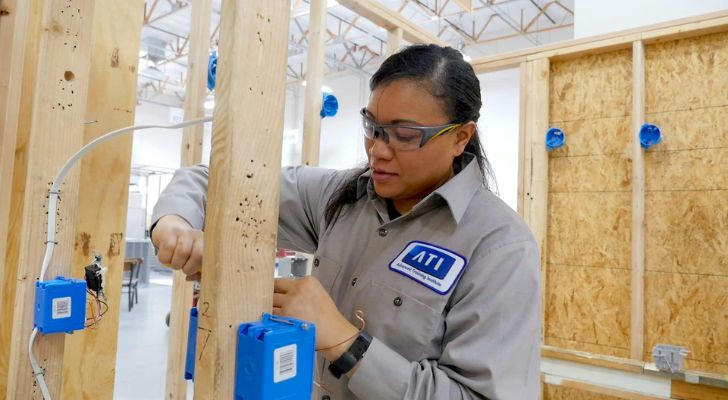Guide to Electrician Training Courses in the United States
1. introduction
Electricians are one of the most indispensable professions in modern society. Whether in residential areas, commercial buildings, or industrial facilities, electricians play a crucial role in ensuring the proper functioning of electrical systems. According to the U.S. Bureau of Labor Statistics (BLS), the job outlook for electricians is very positive, with employment expected to grow by 9% by 2030, which is faster than the average for all occupations. Therefore, electrician training courses not only provide a pathway into this industry but also lay a solid foundation for long-term career development.

2. Overview of the Electrician Profession
The primary duties of an electrician are to install, maintain, and repair electrical systems. These systems range from home circuits to large industrial equipment. Electricians need to have solid technical knowledge, such as electrical principles, circuit diagram interpretation, and troubleshooting skills. Additionally, electricians must adhere to strict safety regulations to ensure a safe working environment.
3. Types of Electrician Training in the U.S.
In the United States, electrician training primarily falls into three categories: apprenticeship programs, vocational technical school courses, and online courses and certifications.
- Apprenticeship Programs
Apprenticeship is the most traditional and common form of electrician training. These programs typically combine hands-on experience and classroom learning, where trainees work alongside experienced electricians to gain practical skills. According to the National Electrical Contractors Association (NECA), apprenticeship programs usually last 4-5 years, with trainees required to complete a certain number of work hours per week while also attending related classes.
- Vocational Technical School Courses
Many community colleges and technical schools offer specialized electrician training programs. Through two years of study, students can obtain a certificate or associate degree in electrical work. The courses cover basic skills such as circuit design, electrical safety, and equipment installation. These programs focus more on theoretical learning compared to apprenticeship programs, allowing students to gain foundational knowledge earlier.
- Online Courses and Certifications
With the rise of remote education, more students are opting for online electrician courses. These courses are typically offered by accredited educational institutions and are suitable for students who prefer flexible learning schedules. While online courses can provide theoretical knowledge, because the electrician profession relies heavily on practical experience, many online programs require students to complete in-person internships.

4. Core Content of Electrician Training Courses
Electrician training courses in the U.S. typically cover the following core areas:
Basic Electrical Knowledge: Fundamental concepts such as electrical principles, current, voltage, and power.
Electrical Installation and Maintenance: How to install and maintain electrical systems in residential, commercial, and industrial settings, including cable wiring and equipment installation.
Safety Standards and Regulations: Safety standards electricians must follow, such as the National Electrical Code (NEC) and Occupational Safety and Health Administration (OSHA) regulations.
Tools and Equipment: Usage of tools and equipment essential for electricians, such as power tools, voltage testers, etc.
5. Certifications and Qualifications for Electricians
In the United States, different states have varying certification requirements for electricians. Typically, after completing an apprenticeship or technical school program, trainees need to pass a state or national certification exam to officially become a licensed electrician. According to BLS data, the median annual income for electricians is $56,180, and certified electricians often have the opportunity to earn higher wages.
6. Advantages of Apprenticeship Programs
Apprenticeship training offers unique advantages. Trainees gain valuable practical experience by directly participating in real work environments. Additionally, apprenticeships often provide a salary, helping trainees cover living expenses during training. After completing their apprenticeship, trainees not only earn a certificate but also gain the experience necessary to secure a job in the industry.
7. Training Duration and Costs
The duration of electrician training varies by program type. Apprenticeship programs typically last 4-5 years, while vocational technical school courses usually last 2 years. Apprenticeship training tends to be low-cost, and some apprentices even receive payment while working. Tuition for vocational technical school courses varies by institution and region, typically ranging from $2,000 to $10,000 per year. Notably, many states offer scholarships and financial aid to help students reduce their financial burden.
8. Career Development Opportunities After Graduation
After completing electrician training, graduates have a wide range of employment opportunities. According to the BLS, the employment areas for electricians are diverse, including residential, industrial, and commercial electricians. Many electricians also choose to become self-employed or start their own electrical contracting businesses. As electrical technology continues to evolve, the demand in fields such as green energy and renewable energy is expanding, providing additional career opportunities.

9. Challenges and Opportunities in Electrician Training
While the outlook for electrician careers is bright, there are some challenges in the training process. First, the work requires a high level of technical skill, and trainees need to invest a considerable amount of time and effort to master these skills. Secondly, electricians often work in hazardous environments, so safety training is crucial. However, these challenges do not hinder the development of the industry; on the contrary, they motivate trainees to improve their skills, earn higher salaries, and gain promotion opportunities.
10. Real-Life Cases
- Case 1: John Smith
John is a young man from California who decided to become an electrician by enrolling in an apprenticeship program after graduation. After 4 years of apprenticeship training, he worked alongside senior electricians to install and maintain electrical systems in several commercial buildings and homes. Upon completing his apprenticeship, John successfully obtained his electrician certification and secured a job with a large construction company. His annual income rose from $45,000 at the start to over $60,000, and as his experience grew, his career prospects continued to improve. John believes that the practical experience gained through apprenticeship was invaluable to his career and helped him stand out in the competitive electrical industry.
- Case 2: Emily Li
Emily is a career woman from New York who decided to switch careers and become an electrician after several years of office work. She chose to enroll in a vocational technical school offering electrician courses and spent 2 years learning the basics of electrical installation, circuit design, and more. After graduation, Emily earned an associate degree and passed the national electrician certification exam. She began working for an electrical engineering company with a starting salary of $50,000, and over time, she successfully advanced to the role of project manager. Emily feels that the vocational technical school courses provided her with solid theoretical knowledge, and although she lacked field experience, she overcame this challenge through fast learning and adaptation.

11. Conclusion
Electrician training courses in the U.S. offer abundant learning opportunities for those aspiring to enter the electrical profession. Through apprenticeship programs, vocational technical schools, and online courses, students can choose the training path that best fits their needs. The electrician profession not only provides stable employment opportunities but also offers relatively high salary potential. With the ongoing development of electrical technology and the renewable energy sector, the demand for electricians is expected to continue growing. Therefore, for those interested in pursuing a career in the electrical industry, receiving professional electrician training is the first step toward success.
